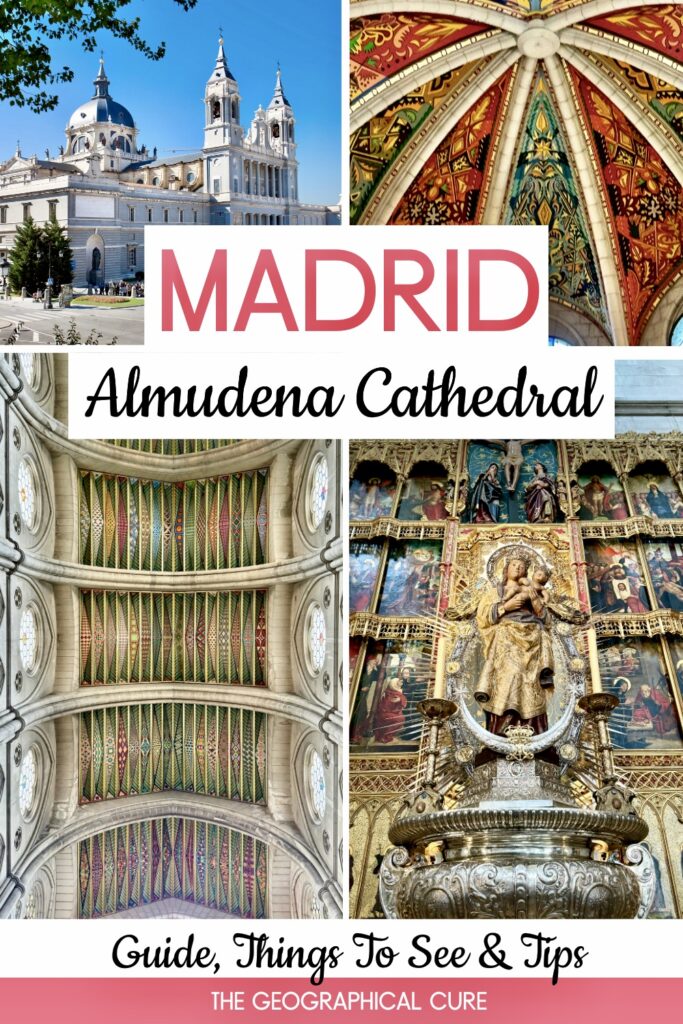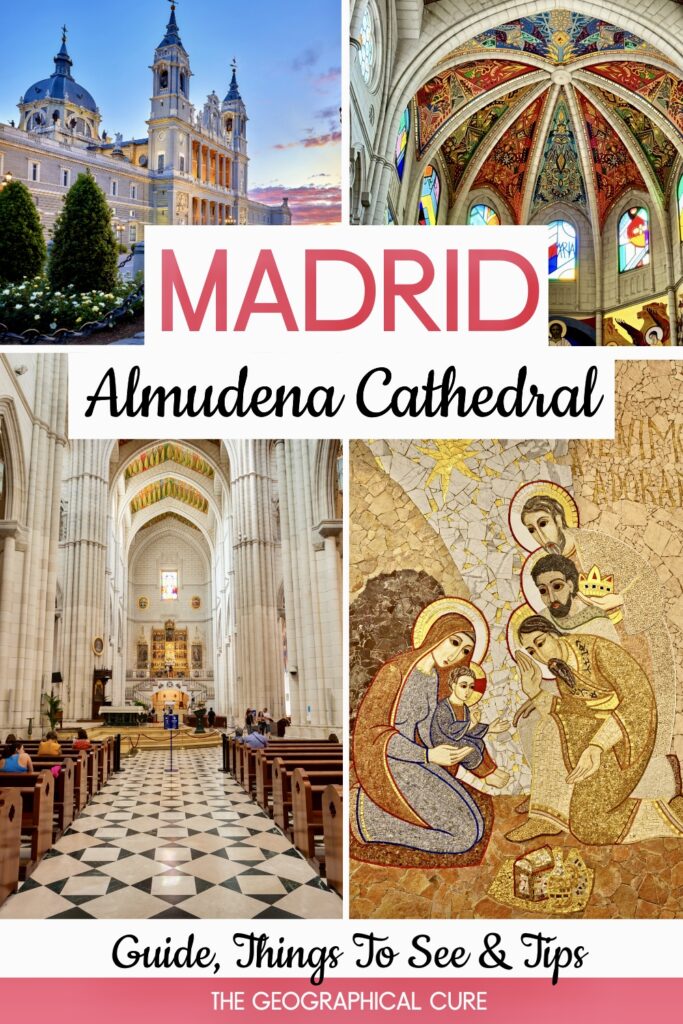The word “cathedral” is typically associated with grand churches built in the Middle Ages. When I mentioned to a guide that I was going to visit Almudena Cathedral, she sniffed and said it “was five minutes old.”
Forewarned with this information, I nonetheless visited. It wasn’t like seeing Toledo Cathedral, of course.
But I thought it was still reasonably aesthetically pleasing, especially inside. And the views from the roof are sublime.
For a capital city, Madrid was deprived. It didn’t have its own cathedral until Pope John Paul II consecrated Almudena in 1993.
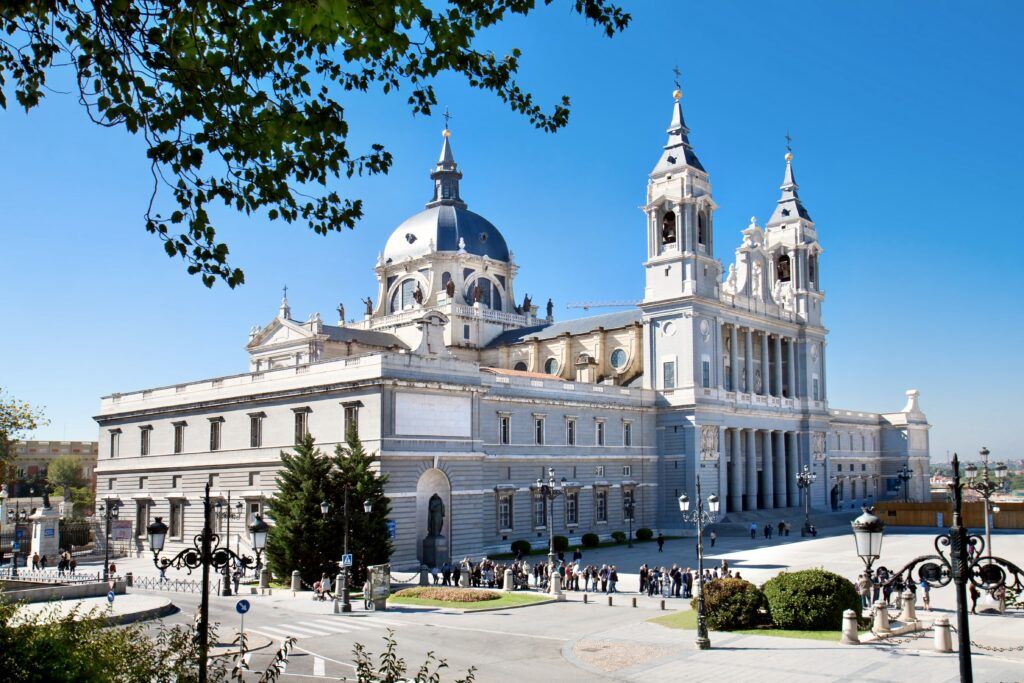
It took more than a century to build, proceeding in several phases with long periods of inactivity and delay.
At first, the Madrileños didn’t much care for the new cathedral.
But it became more popular after King Fellipe VI and Queen Letizia were married there in 2004.
Mini History Of Almudena Cathedral
Construction began during a period of economic prosperity following the restoration of the monarchy in the late 19th century.
The first plan was for a cathedral in the Gothic revival style and a large Romanesque crypt.
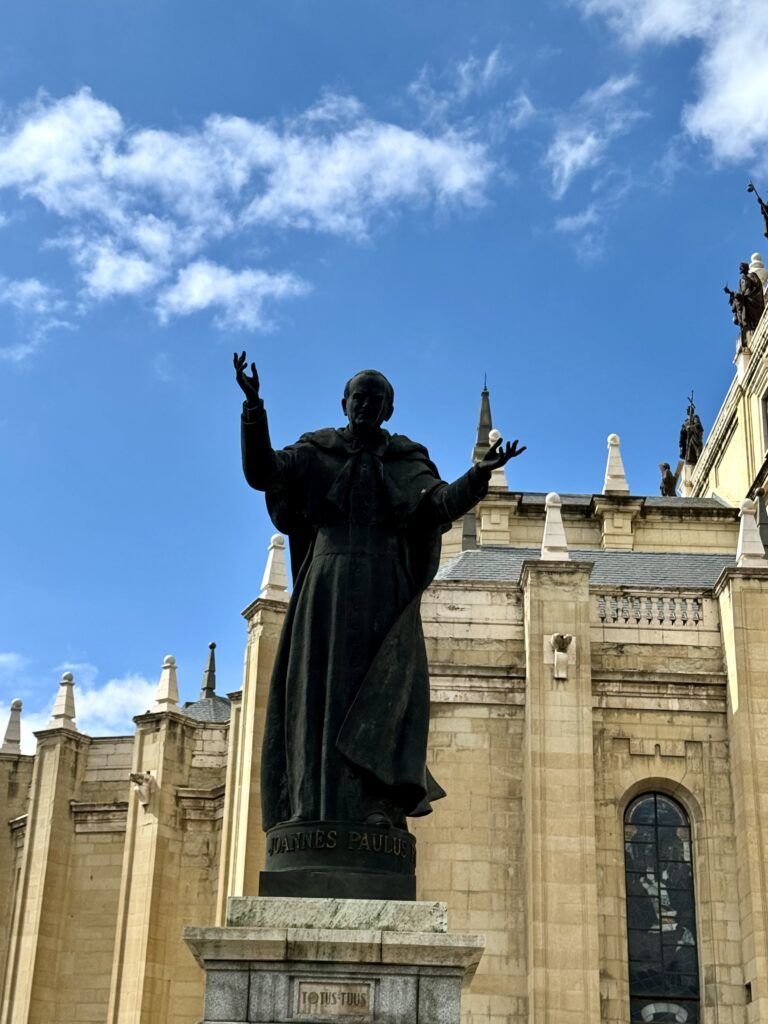
The crypt was finished speedily enough in 1911. But the cathedral was not completed.
Political upheaval, financial problems, and the Spanish Civil War temporarily put the cathedral on ice.
Every time work began again, with a raft of new architects, the design was altered. The result is a facade that’s quite eclectic, to put it mildly.
In the 1940s, two architects came along and encased the whole building in a Neoclassical shell. They felt it was more consistent with the Royal Palace.
The name “Almudena” is Arab in origin. The cathedral is named after the Virgin of Almudena, the patroness of Madrid.
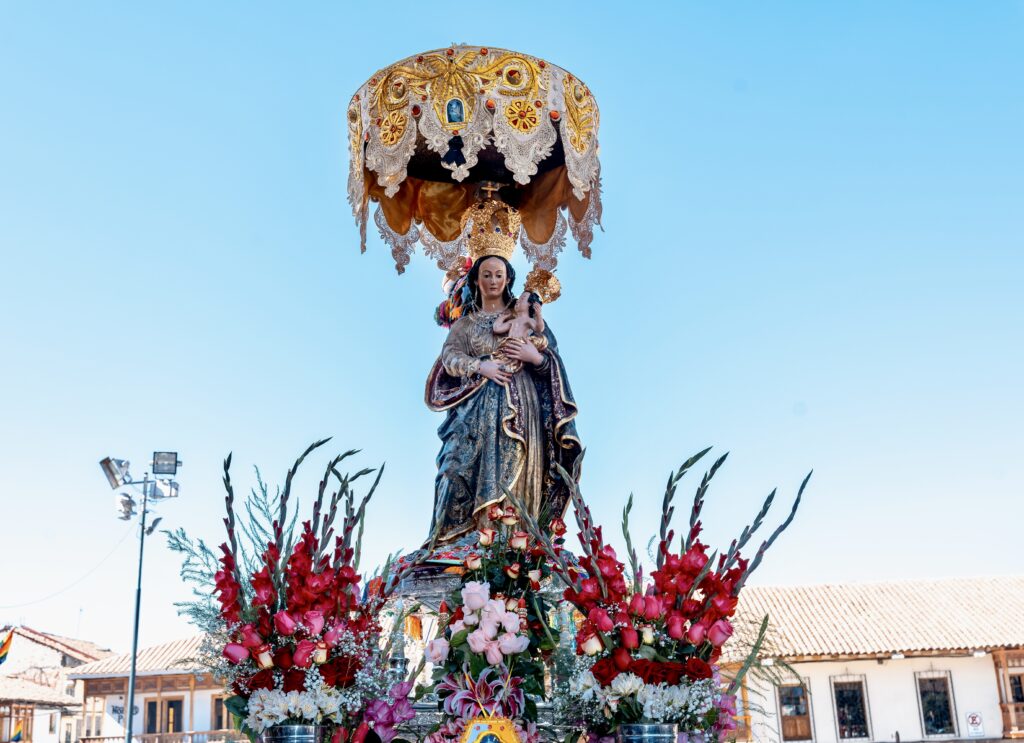
According to legend, in the 8th century, Visigoth settlers hid an image of the Virgin Mary in the city walls during the period of Moorish rule to protect it.
Centuries later, after the Christian reconquest, the figure miraculously reappeared near the city’s old medieval fortress. Ever since, her image is venerated and celebrated.
In 1993, the pope consecrated the cathedral and dedicated it to Saint Mary of Almudena. It’s now the seat of the Archdiocese of Madrid.
November 9 is the feast day of the Virgin of Almudena. A procession is held in her honor. The statue of the virgin, covered in flowers, is carried through the streets.
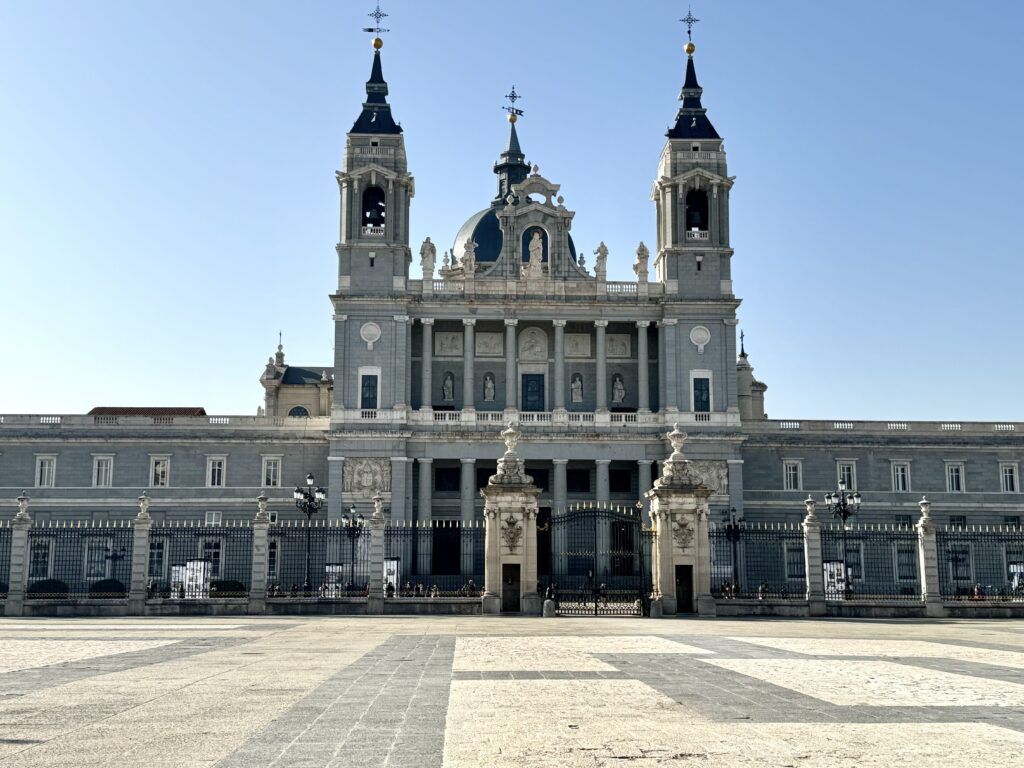
Guide To Almudena Cathedral: What To See
Main Facade
The main facade of the cathedral is opposite the main facade of the cathedral, making it quite dashing (if a lot of gray).
There are three bronze doors with intricate bas reliefs, made by Luis Sanguine. Two bell towers flank the portals.
The facade is crowned by four statues in white stone representing Spanish saints. In the center, under a Baroque style gable, is a statue of Our Lady of Almudena.
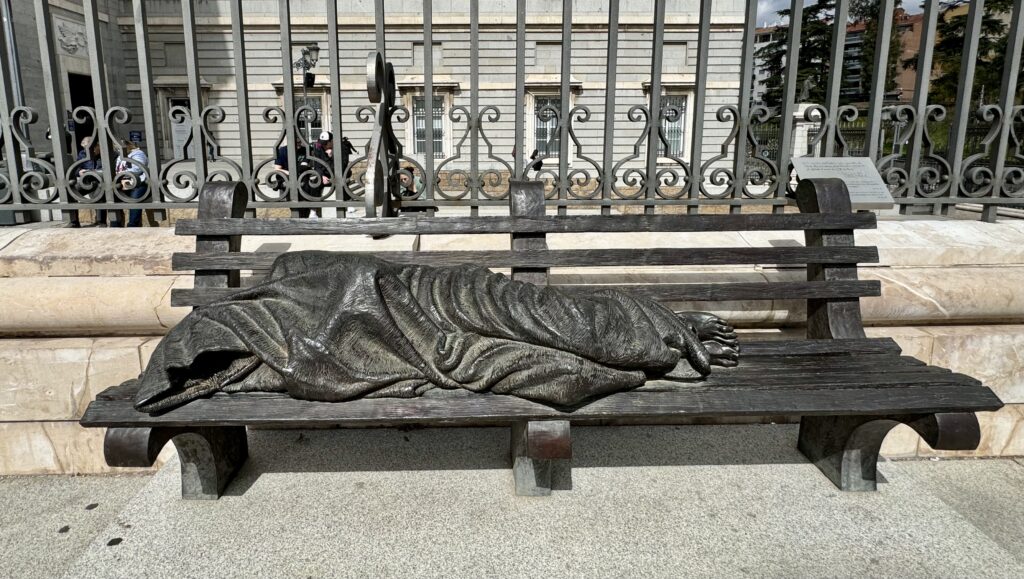
The eastern side, on Calle de Bailen, is where you enter.
Outside is the Monument to Pope John Paul II and an unusual work by Canadian sculptor Timothy Schmaltz, which shows a homeless Christ on a bench covered by a blanket.
Like the main facade, the portals have intricate reliefs, mostly relating to Madrid’s patroness.
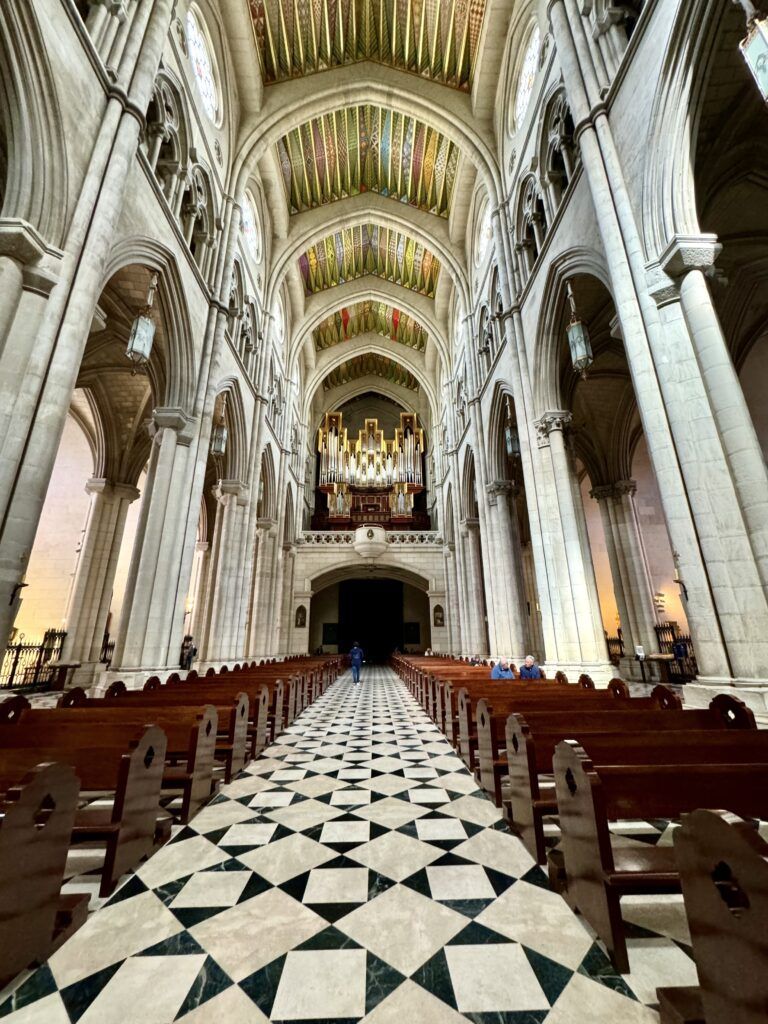
Interior
Inside, the cathedral is Neo-Gothic.
It has a Latin cross plan, with a central nave and two side aisles. The aisles are filled with chapels.
The chapels have some lovely contemporary stained glass, and are devoted to contemporary saints and famous citizens of Madrid.
Light floods into the side naves through upper rose windows.
On the wall near the main door, you can see two paintings by Francisco Zurburan, a famous Spanish Baroque master.
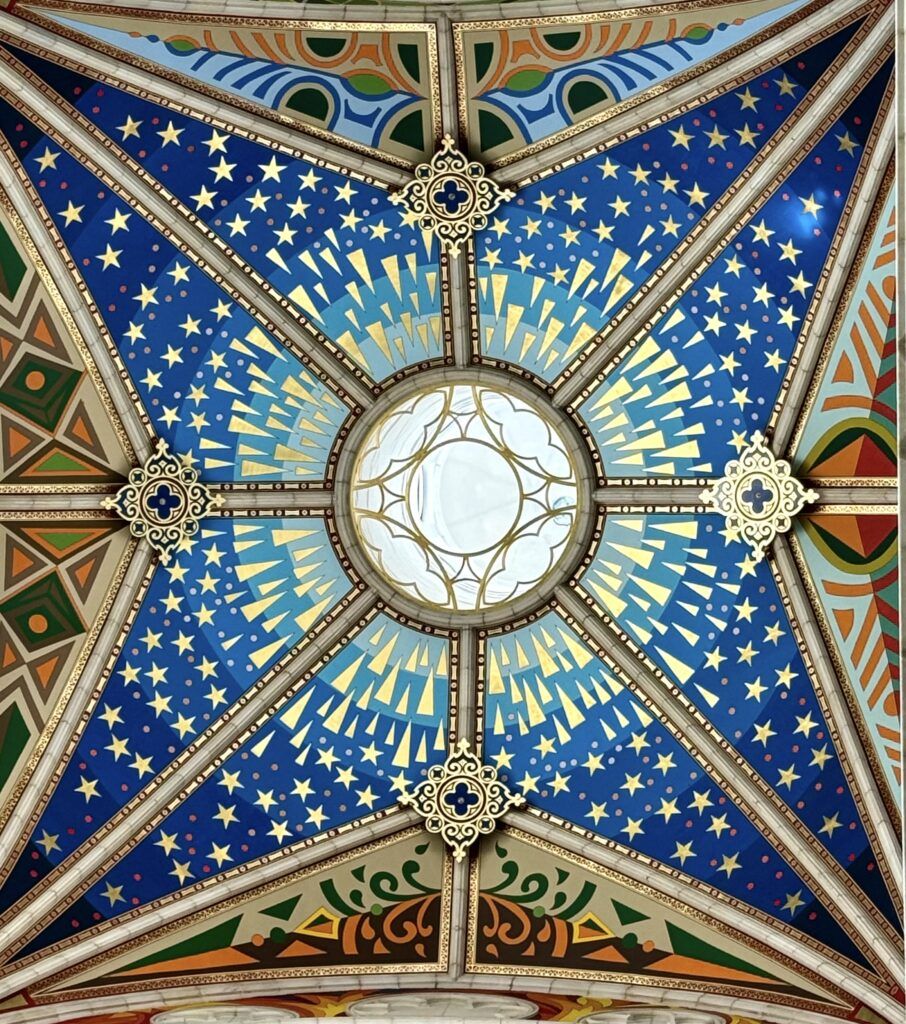
Dome
One of the prettiest parts of the cathedral is its dome.
It’s a double dome, with the ribs of the inner dome forming a star. It was inspired by 15th century Gothic domes.
The background is a deep blue and dotted with stars, as if it were a celestial vault. In the lunettes, the artist depicts the four elements of nature (earth, water, fire, and air).
On the exterior, 12 bronze statues surround the dome, representing the 12 apostles.
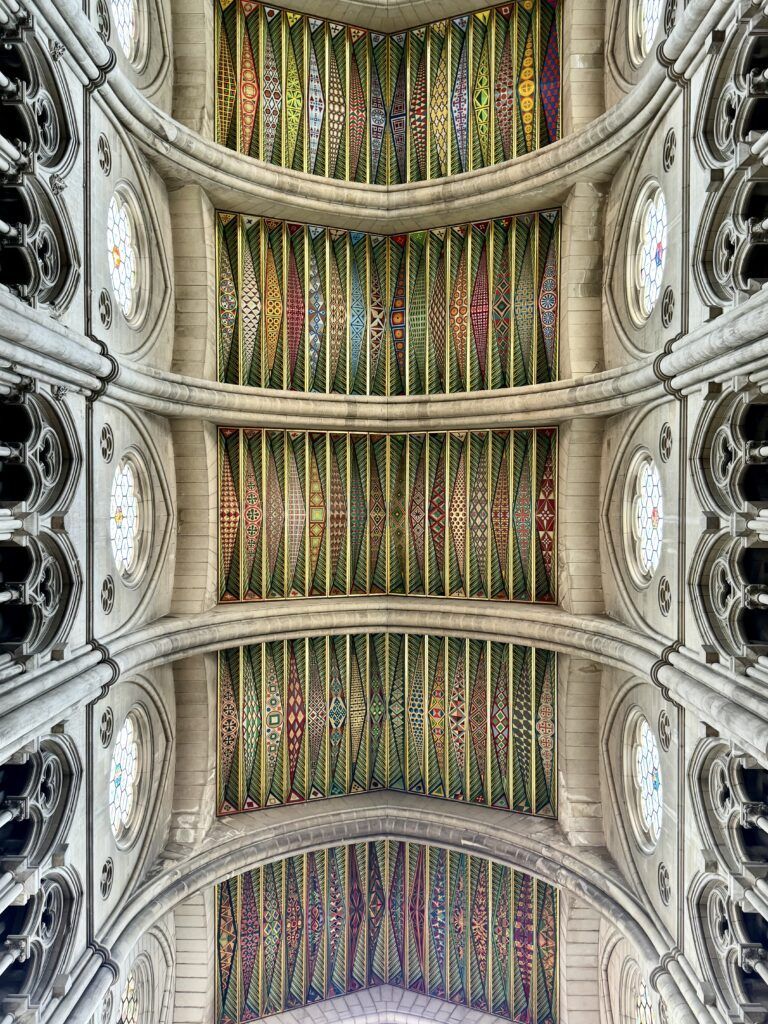
Ceilings
The cathedral ceilings are colorful and eye catching. Inspired by Moorish designs, Jose Luis Galicia painted them between 1997-98.
They are full of geometry and fluorescent colors, which are a stark contrast to the white walls.
Each section is unique and different from the others.
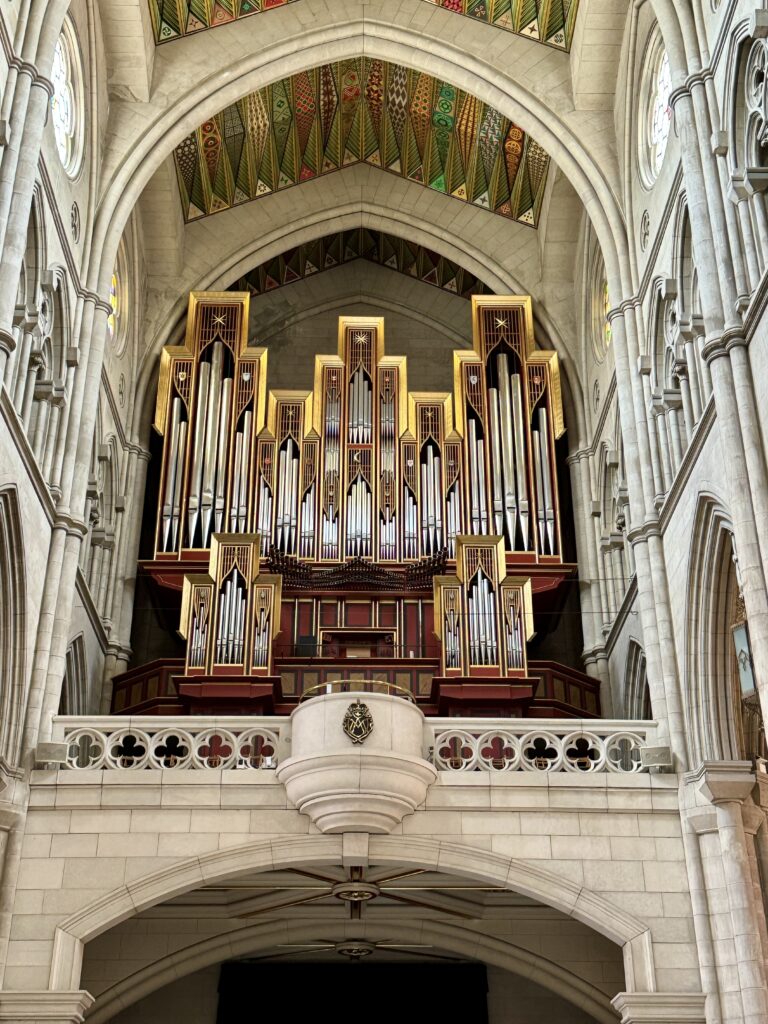
Organ
The monumental organ arrived in 1999, made in Barcelona.
It combines the tradition of Central European organs with those of the Iberian school.
The organ is equipped with both mechanical and electrical systems. It has nearly 5,000 pipes.
The case was designed by Brit architect Simon Platt, who was inspired by Gothic designs.
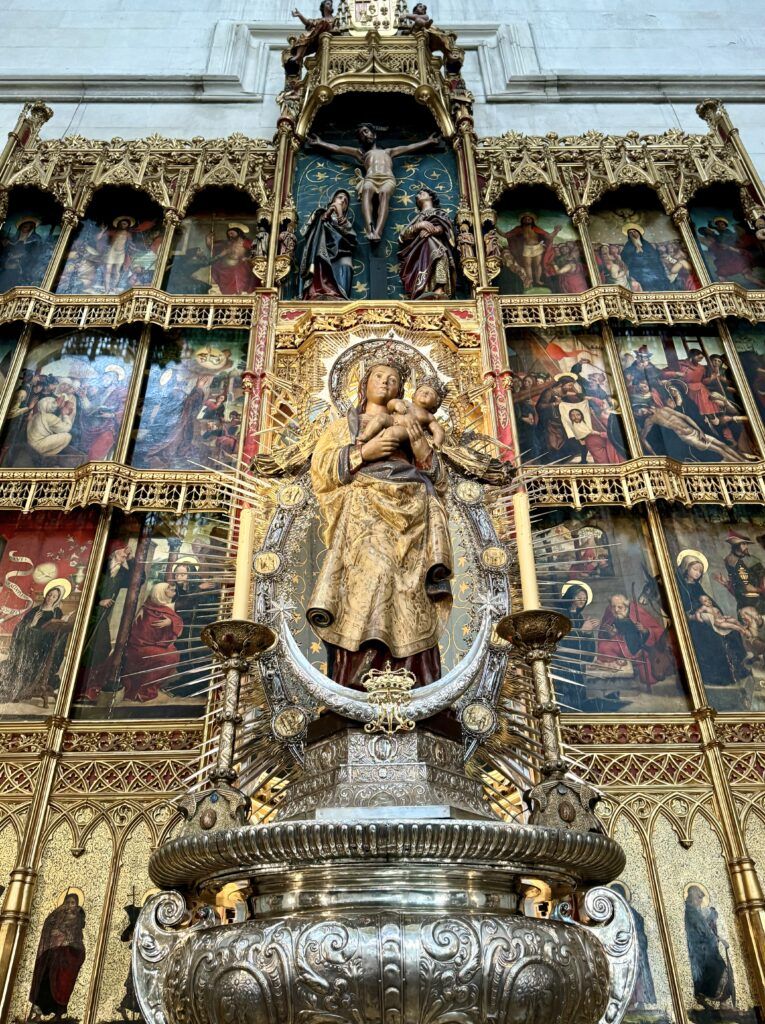
Altar of Our Lady of Almudena
This eye catching altarpiece is the main alter in the cathedral. in the center, Our Lady sits on a silver throne.
The image you see is a wooden sculpture made in the early 16th century by Dutch artists Diego Copin. Mary has a round, sweet face and expressive eyes.
Mary’s mantle and tunic are finely carved with great realism. The polychrome was produced used a technique known as “quilted silk.”
The extraordinary altarpiece is formed by 18 panels painted by Juan de Borgona in the early 16th century. They depict scenes from the life of Christ.
On both sides of the altarpiece are paining of two ascending angels. Below are two small gilded altarpieces.
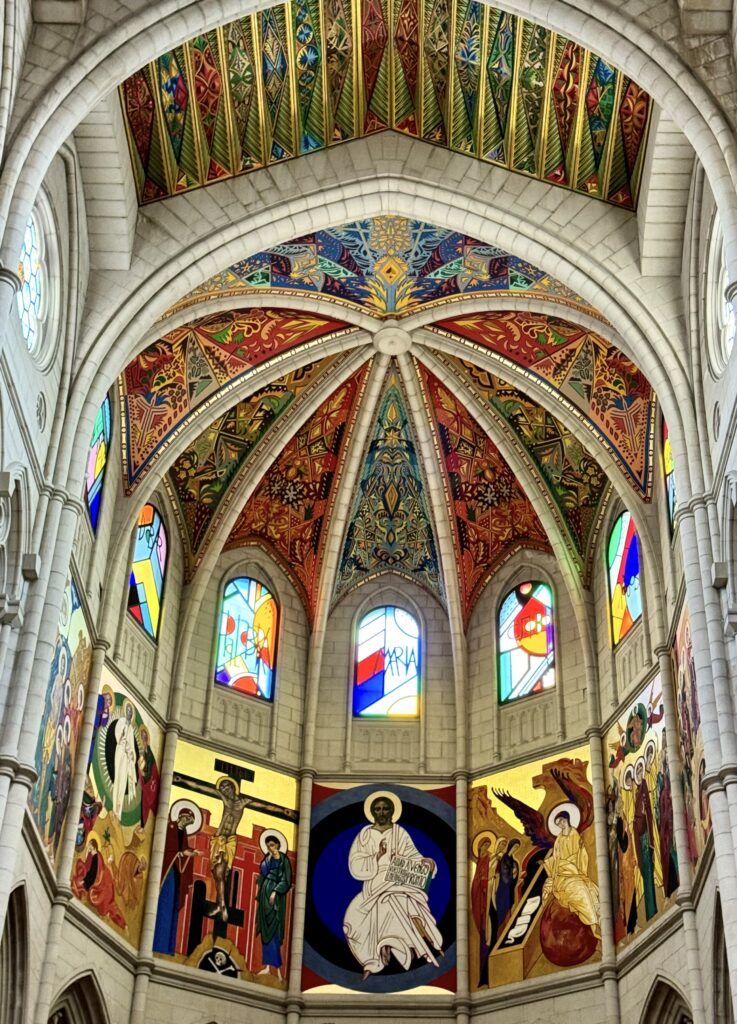
Chancel
The chancel is the elevated space in the center of the cathedral, where you also find the apse.
The chancel is adorned with a series of severn murals forming the so called “Mystery of the Crown of Thorns.” There are five scenes from the life of Jesus — the usual resurrection, crucifixion and ascension.
In the center of the composition is the image of the Christ Pantocrater, frequently found in Byzantine mosaics.
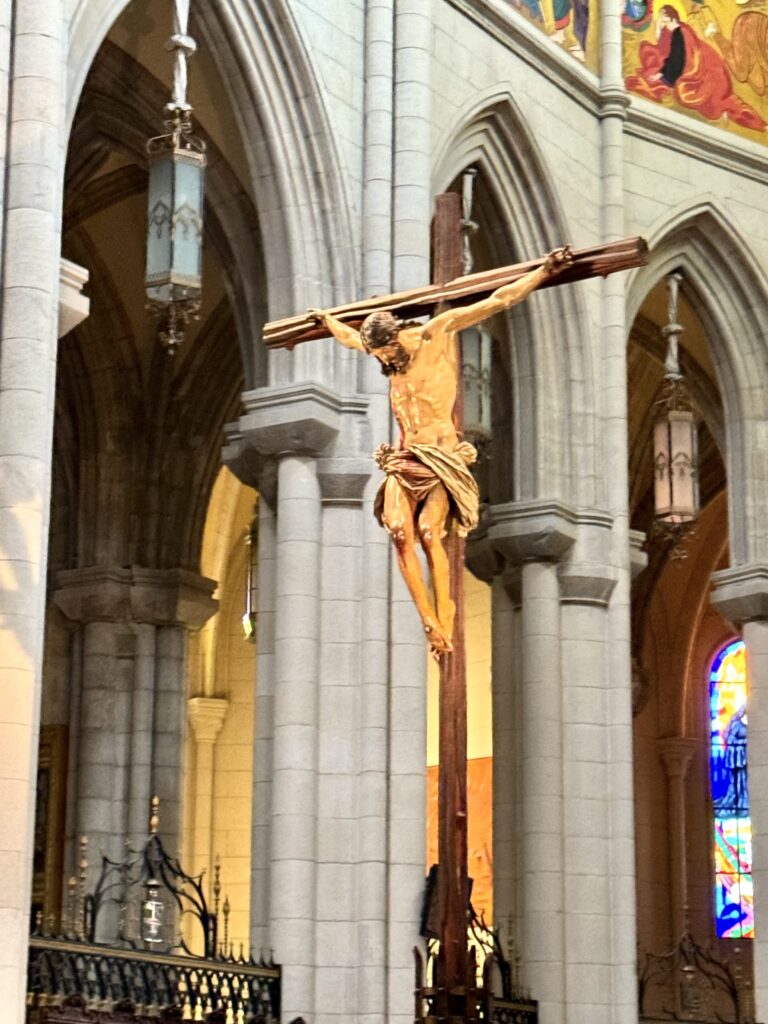
The images were painted by Kiko Argüello, a fairly inexperienced painter and friend of the pope. The choice was controversial in Madrid, some claiming the Byzantine images were amateurish and inappropriate for a cathedral.
The seven stained glass windows are emblazoned with the word God in several different languages. They were made in Murano and installed in 2004.
Presiding over the altar is a beautiful carving of the Christ of the Good Death. It was crated in 1993 by Sevillian sculpture Manuel Berjarano.
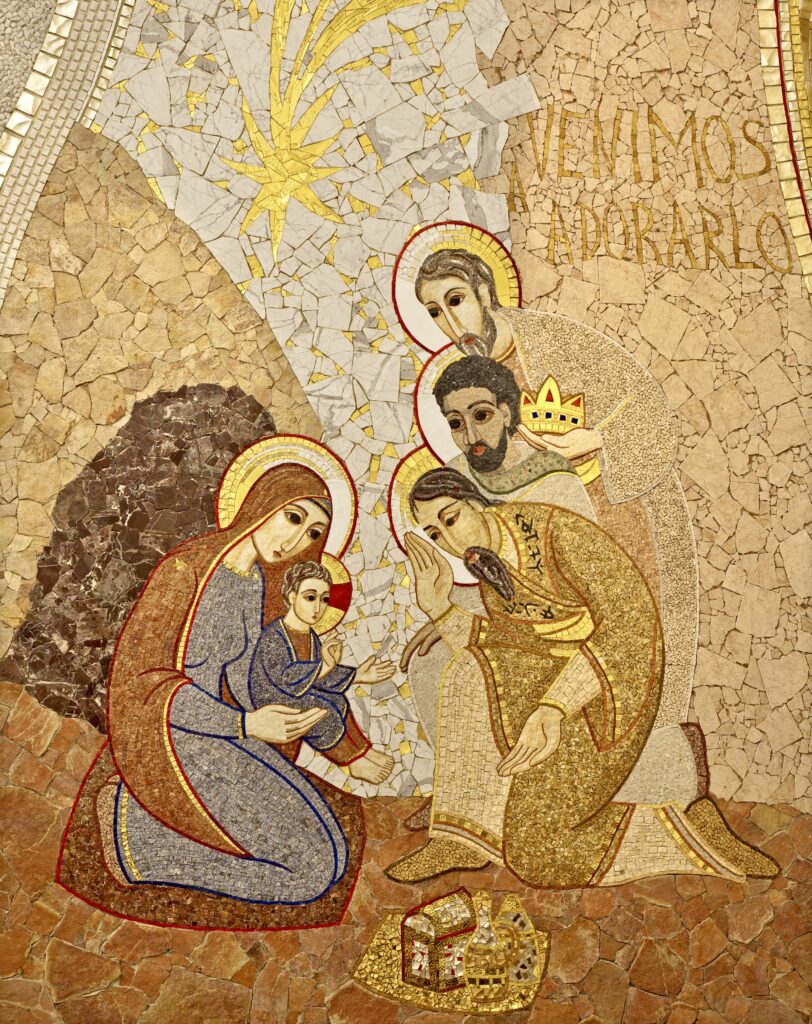
Mosaics
The cathedral is home to beautiful mosaics from 2005-11, mostly in the Sacristy, Chapter House, and Chapel of the Holy Sacrament.
These are part of the museum and that’s the only way you can see them.
The most striking one to me was the Pieta in the Chapter House, in which Mary embraces her dead son.
The chapel is also beautiful and seems bathed in gold mosaics. You’re greeted by the Adoration of the Magi.
There are representations of the parable of the Good Samaritan and Jesus performing the miracles of the loaves and fishes.
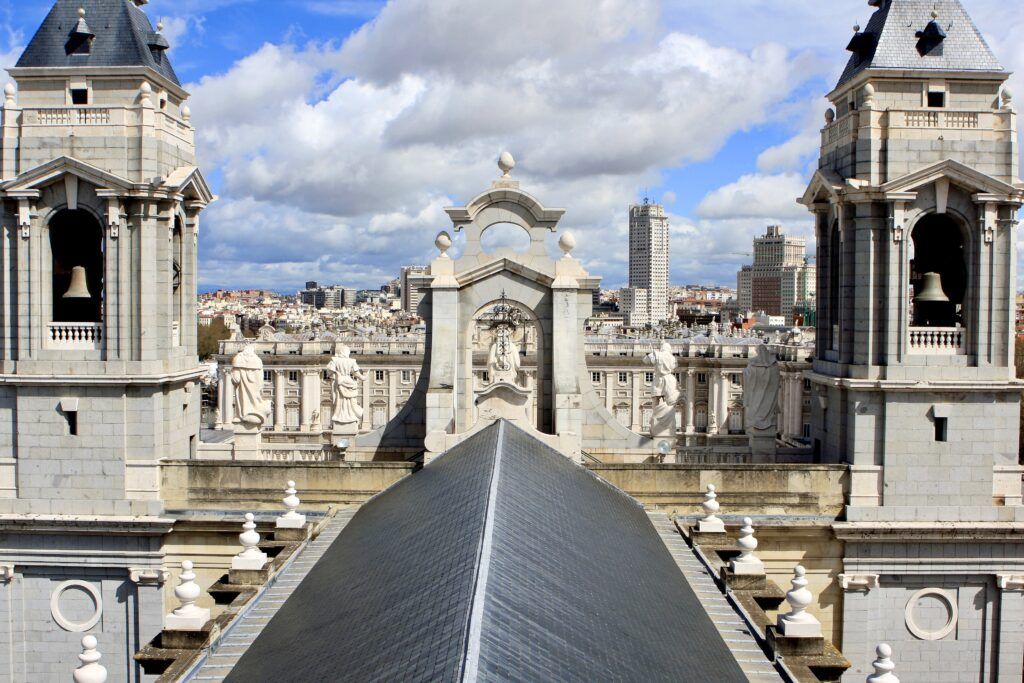
Cathedral Museum & Roof
The Cathedral Museums opened in 2007 and is housed in the galleries over the site aisles. A tour of the museum is completed by a visit to the dome to enjoy the superb views.
Along the way, you’ll see a collection of devotional treasures and sacred artworks.
The most important pieces include a codex with an oral history of Madrid, vestments, a 17th century golden monstrance, and a Belgium tapestry.
You can also see models of prior itinerations of the cathedral.
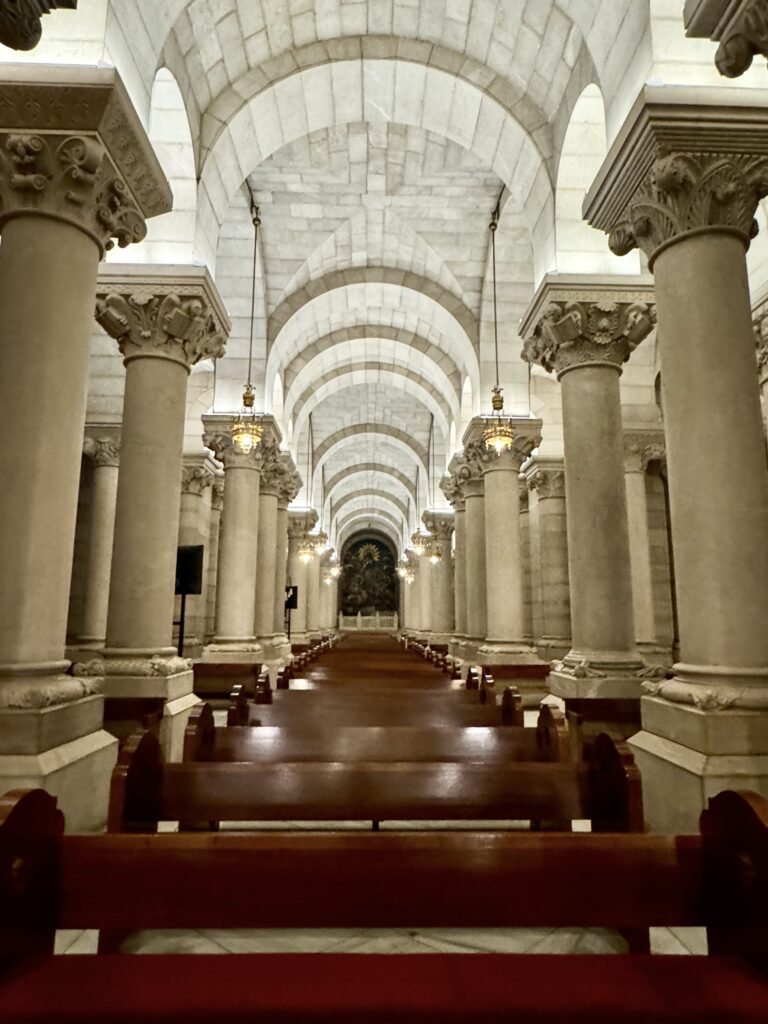
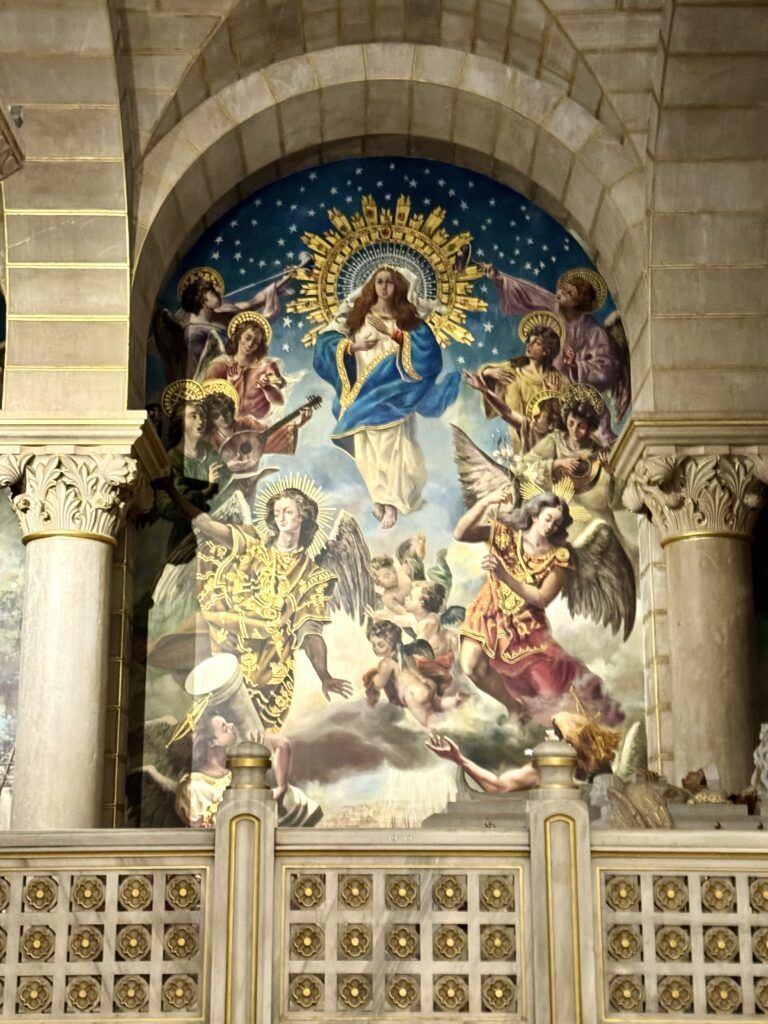
Cathedral Crypt
The crypt may be more interesting than the cathedral itself. You access it via a stone staircase inside the cathedral or by the main door to the side of the cathedral on Cuesta de la Vega.
It’s the largest crypt in Spain. It features scores of Neo-Romanesque capitals, which are adorned with castles, plants, and animals.
The crypt is illuminated by light from the stained glass windows.
The chapels inside contain the tombs of important 19th century families. Flowers are still left on the floor tombs.
Presiding over the presbytery behind the high altar is a copy of the image of Our Lady of Almudena.
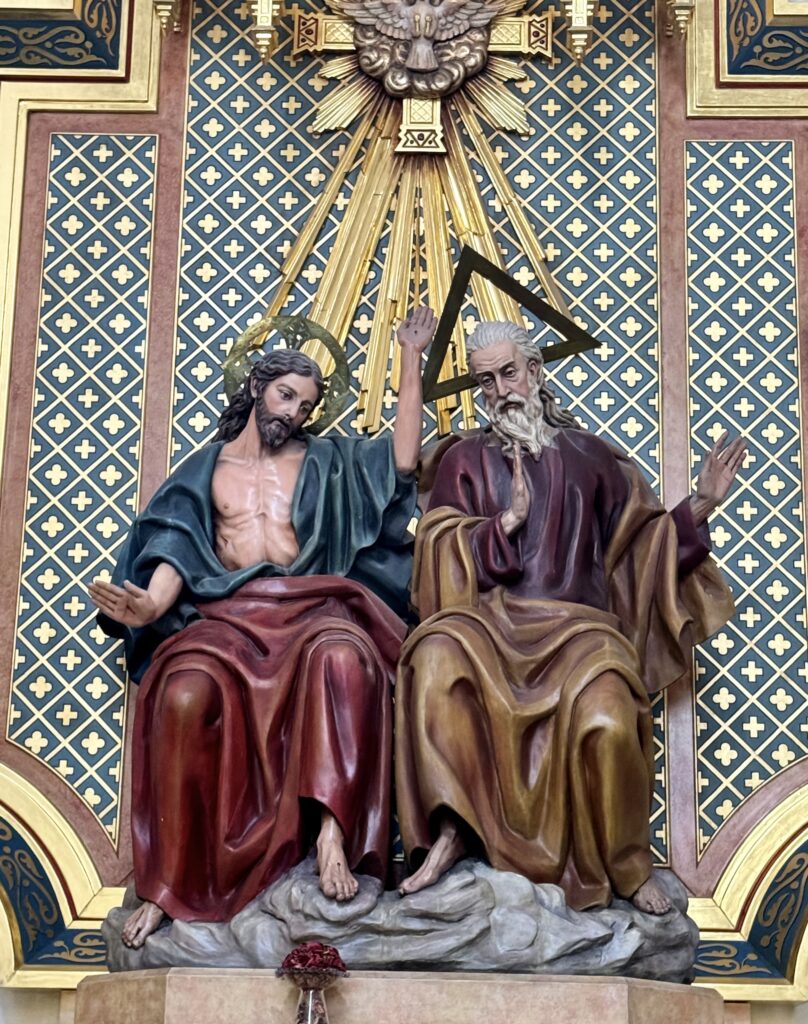
Practical Guide & Tips For Almudena Cathedral
Address: Plaza de la Almudena. The main entrance is accessed from Calle de Bailén, not the front of the cathedral.
Hours:
The church is open 9:00 am to 8:30 pm. However, there is no entry during mass, which is at 12:00 pm, 6:00 pm, and 7:00 pm.
The crypt is open from 10:00 am to 2:00 pm and from 4:30 pm to 8:00 pm. The museum and tower are open from 10:00 am to 2:30 pm Monday through Saturday.
Tickets: The cathedral and crypt are both free with a requested one euro donation. The tower and museum are 7 euros. You buy tickets at the museum’s ticket office.
>>> Click here to book a guided tour of the palace and cathedral

Pro Tips: If you want to climb the tower for views, it closes at 2:30 pm. So try to arrange your visit before lunch.
Is Almudena Cathedral Worth Visiting?
Well, it depends on your mindset.
If you are visiting the Royal Palace, the cathedral is right next door, so why not pop inside and check out a more modern cathedral?
Plus, it’s perfectly free except for the museum and tower. And I enjoyed the stained glass and even the — gasp — ceilings rendered by an unknown artist.
To the right of the front facade is the Royal Collection Gallery. So, You can combine all three sites connected to the royal family, which makes for a good day of sightseeing.
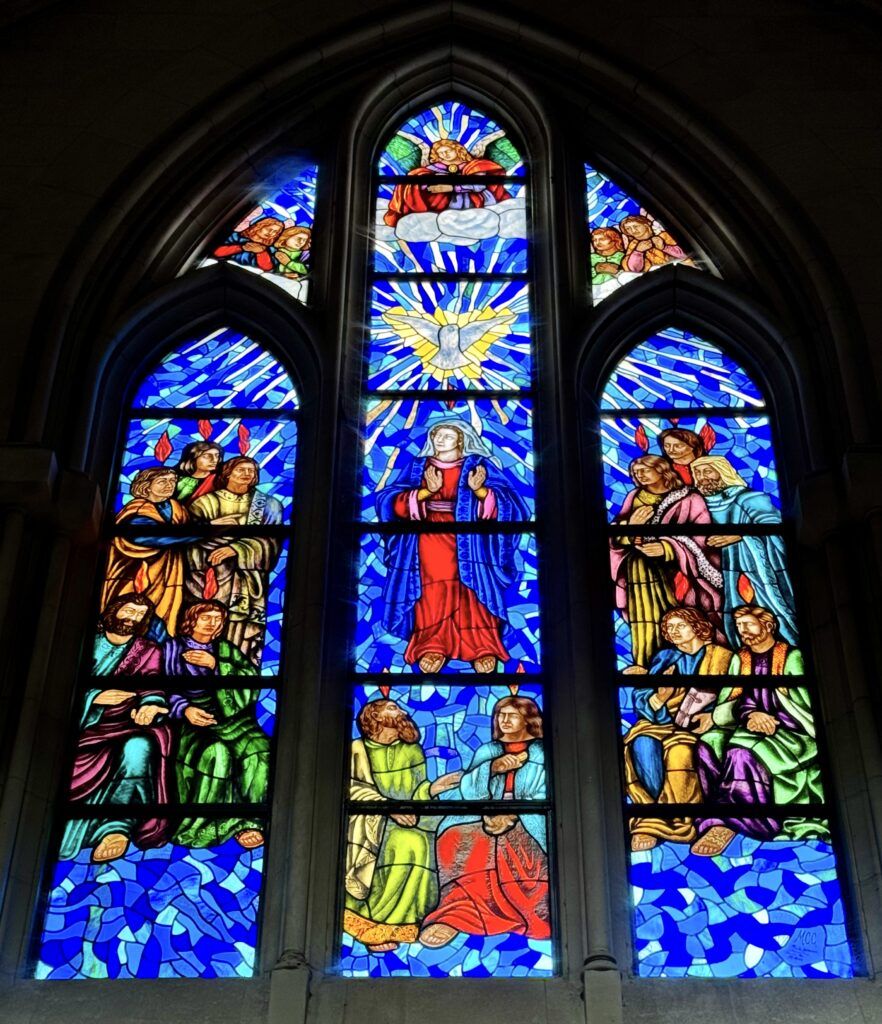
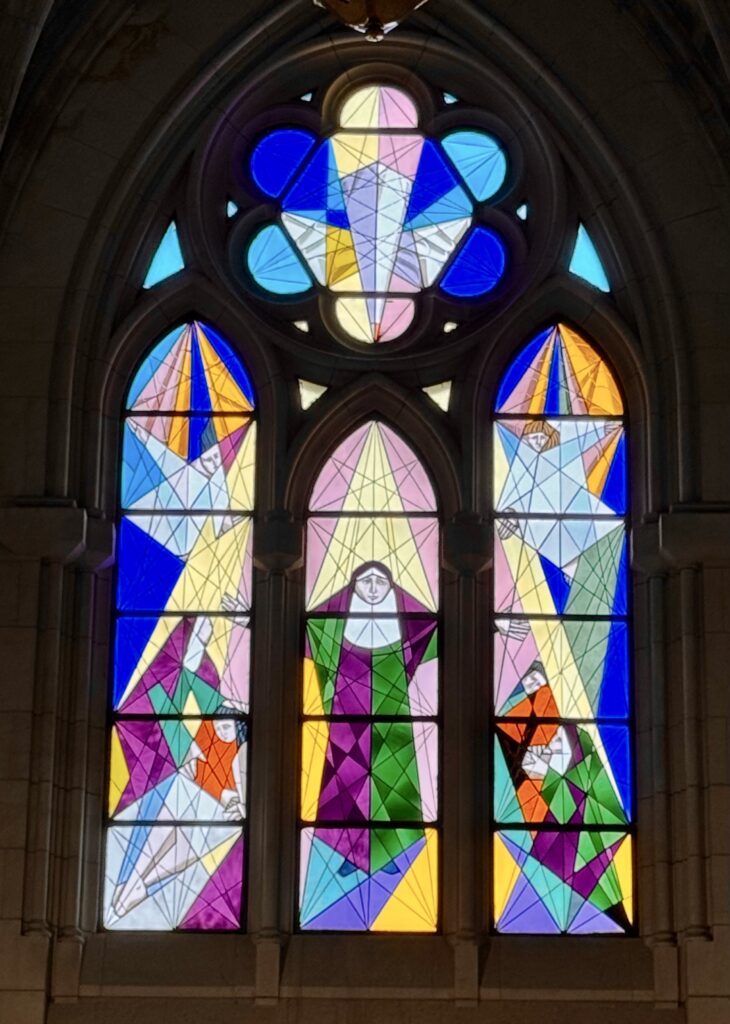
On the other hand, if you are a cathedral snob (and I am a bit), then you could skip it and just admire the facade. From Calle Factor, there is a beautiful view of it lit up at night.
To most Europeans, Almudena may seem rather ugly because it’s a combination “Neos,” and not a genuine Gothic or Baroque church.
And, to be sure, it simply doesn’t have the pomp and prestige of other cathedrals. But you never know … wait a few hundred years.
I hope you’ve enjoyed my guide to Almudena Cathedral. You may find these other Madrid travel guides useful:
- 2 days in Madrid itinerary
- best museums in Madrid
- guide to the Royal Palace
- guide to the Prado Museum
- guide to the Reina Sofia Museum
- guide to the Thyssen-Bornemisza
- guide to the Royal Collection Gallery
Pin it for later.

